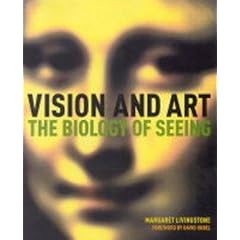 I’ve written a couple of times about a book that has fascinated me for some time, Margaret Livingstone‘s “Vision and Art: The Biology of Seeing”. Written by a Harvard neurobiologist, it is a surprisingly approachable explanation of how we’re wired to see and the application of that understanding to art. I’m not a fan of the sciences, but this book’s illustrations go a long way to making a complex subject relatively simple.
I’ve written a couple of times about a book that has fascinated me for some time, Margaret Livingstone‘s “Vision and Art: The Biology of Seeing”. Written by a Harvard neurobiologist, it is a surprisingly approachable explanation of how we’re wired to see and the application of that understanding to art. I’m not a fan of the sciences, but this book’s illustrations go a long way to making a complex subject relatively simple.
 When writing about my “drying mantle” the other day, I wrote about how color balance changes based on the amount of available light illuminating the painting. This is backed up by our visual systems biology.
When writing about my “drying mantle” the other day, I wrote about how color balance changes based on the amount of available light illuminating the painting. This is backed up by our visual systems biology.
It’s a bit too complex to explain in a short blog post, but this Wikipedia entry on the Luminosity gives a relatively short overview. The impacts to viewers of your art include the following facts:
- Our visual system is more responsive to Green and Yellow light than Red, Blue to Violet (see the diagram below–the colors in center are most visible in daylight whereas colors towards the ends less so). Therefore, if your painting is placed in low light, the green and yellows will hold up, whereas the blues, violets and reds will loose their intensity.
- Colors also change value based on light. In low light, reds become darker and blues become lighter. If for example you were to paint cherries in a blue bowl of the same value (or even a blue darker than the cherries), in low light, the red cherries will look darker.

Of course, in the end, these differences in visual perception are interesting, but ultimately not crucial. Our intentions as artists, as communicated through design, brush stroke and of course subject matter is much more important.
This is a favorite book of mine as well. Another aspect of the book that I found interesting was her chapter on the art of the impressionists, and how using blobs of color can create the impression of movement because of how our peripheral vision is processed by the brain. Right after I read the book I went to an exhibit of Monet’s paintings and it added another level to my appreciation of his paintings.
Thanks for mentioning the book and raising the subject. I hadn’t thought about it before.
As I read the data, though, I reach a slightly different conclusion about the effects of low light on paintings. According to the chart in the Wikipedia article, blues will be MORE intense in low light, as will violets (blue purples). It’s reds and oranges that will suffer, while greens and yellows will be largely unaffected. To a rough approximation, then, warm colors suffer in low light. Low light cools paintings. Is this right or am I missing something?
Decker, you may be right. My lack of science training shows. Anyone else reach Decker’s conclusion? Any physicists or neuralbiologists reading this?